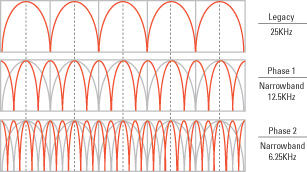| NARROWBANDING DEADLINE HAS |
Click HERE to view our Narrowbanding reference sheet
FCC Narrowband Mandate
Key Points About FCC Narrowbanding Requirements
- Many current public safety radio systems and private radios systems use 25 kHz-wide channels.
- The Federal Communications Commission (FCC) has mandated that all non-Federal public safety licensees using 25 kHz radio systems migrate to narrowband 12.5 kHz channels by January 1, 2013.
- Licensees that do not meet the deadline face the loss of communication capabilities.
- Licensees need to start planning now to migrate to narrowband systems by assessing their current radio equipment and applying for new or modified licenses.
Overview

Figure 1: Narrowband channels allow additional channels to exist in the same spectrum.
Private land mobile radio (LMR) systems—including municipal government and State and local public safety systems—use blocks of radio spectrum called channels. Historically, LMR systems have used 25 kHz-wide channels. In December 2004, the Federal Communications Commission mandated that all private LMR users operating below 512 MHz move to 12.5 kHz narrowband voice channels and highly efficient data channel operations by January 1, 2013. This migration complements a National Telecommunications and Information Administration mandate for more rapid Federal agency migration to 12.5 kHz narrowband operation by January 1, 2008. The earlier Federal deadline affects State and local FCC licensees that interface or share frequencies with Federal radio systems.
Using narrowband channels will ensure that agencies take advantage of more efficient technology and, by reducing channel width, will allow additional channels to exist within the same spectrum space, as illustrated in figure 1.
Deadlines
To phase in the migration deadline of January 1, 2013, the FCC has established interim deadlines. The first important deadline is January 1, 2011, after which:
- The FCC will not grant applications for new voice operations or applications to expand the authorized contour of existing stations that use 25 kHz channels. Only narrowband authorizations will be granted.
Planning for the Move to Narrowband
Licensees need to aggressively develop a strategy to meet narrowband deadlines to avoid cancellation of existing wideband FCC authorizations. Although the migration deadline may seem far off, the long lead time and interim deadlines make it necessary for agencies to plan well in advance.
Assess current equipment and start planning.To prepare for the migration, licensees should start assessing their radio systems and planning for replacements or upgrades. They should inventory their current equipment to ascertain what can be converted to 12.5 kHz and what will need to be replaced before January 1, 2013. Most new equipment has the capability for both 25 kHz and 12.5 kHz. The 12.5 kHz narrowband equipment is available in both conventional analog FM and digital formats (such as Project 25), so narrowband conventional FM systems will be compliant.
Obtain new or modified licenses.To move to narrowband operations, agencies must apply for new frequencies or modify existing licenses. An agency that is licensed for a 25 kHz-wide channel is not guaranteed two 12.5 kHz channels. Licensees will have to justify to the FCC why they need additional channels. Consideration of applications for new narrowband licenses will follow the same process as a new license application. As agencies migrate to narrowband operation, however, the pool of available frequencies will increase.




